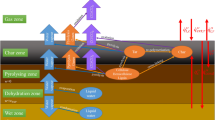Abstract
A great demand for wood material has led to an increase in the price of industrial wood in the past and will raise it even further in future. Industry and research have reacted to this increasing price of wood, for example, by developing weight-reduced particleboard. One approach to achieve this reduction in weight is to use suitable chip geometries in the core layer instead of lightweight, resource-saving filling materials. The geometry of the chips in the core layer must have a high compression resistance here to reach the desired apparent density profile. For this purpose, particle geometries were analysed with regard to this property within a project for the development of weight-reduced particleboards. After determining the curve of the compression resistance, it was possible to establish an equivalent spring stiffness model for different chip geometries to characterise the geometry during compression. Merely due to a low bulk density for chips in the core layer, it is not possible to increase the spring stiffness and hence to reach a required apparent density profile. Only compression of the chips leads to a rapid increase in spring stiffness.






Similar content being viewed by others
References
Benthien JT, Ohlmeyer M (2017) Influence of face-to-core layer ratio and core layer resin content on the properties of density-decreased particleboards. Eur J Wood Prod 75(1):55–62
Benthien JT, Ohlmeyer M, Schneider M, Stehle T (2017) Experimental determination of the compression resistance of differently shaped wood particles as influencing parameter on wood-reduced particleboard manufacturing. Eur J Wood Prod. https://doi.org/10.1007/s00107-017-1270-z
Hänsel A, Niemz P, Brade F (1988) Untersuchungen zur Bildung eines Modells für das Rohdichteprofil im Querschnitt dreischichtiger Spanplatten [Investigations for the development of a model for the density profile in the cross section of three-layered particleboard]. Holz Roh Werkst 46(4):125–132
Klauditz W, Buro A (1962) Die Eignung von Sägespänen zur Herstellung von Holzspanplatten [The Suitability of Sawdust for Particleboard Manufacture]. Holz Roh- Werkst 20(1):19–38
Michanickl A (2007) Innovationsworkshop Holzwerkstoffe: Leichte Holzwerkstoffe für den Möbel- und Innenausbau. Zwischen Nische und Massenproduktion [Innovation workshop for wood-based materials: lightweight wood-based materials for furniture and interior finish. Between niche and mass production]. Rosenheim, Fair Interzum, Köln
Paulitsch M, Barbu M (2015) Holzwerkstoffe der Moderne [Wooden materials of the modern age]. DRW Verlag, Leinfelden- Echterdingen
Plath E, Schnitzler E (1974) Das Rohdichteprofil als Beurteilungsmerkmal von Spanplatten [The density profile, a criterion for evaluating particleboard]. Holz Roh Werkst 32:443–449
Rackwitz G (1963) Der Einfluss der Spanabmessungen auf einige Eigenschaften von Holzspanplatten [Influence of chip dimensions on some properties of wood particleboard]. Holz Roh- Werkst 21(6):200–209
Sackey EK, Semple KE, Oh S-W, Smith GD (2008) Improving core bond strength of particleboard through particle size redistribution. Wood Fiber Sci 40(2):214–224
Statistisches Bundesamt (2015) Produzierendes Gewerbe 2014, Fachserie 4 Reihe 3.1 [Manufacturing industry 2014, specialized publication 4 series 3.1]. Federal Office of Statistics, Wiesbaden
Acknowledgements
The authors would like to thank Fachagentur Nachwachsende Rohstoffe e.V. (FNR), Gülzow, Germany, for its financial support and all those who were engaged in the experimental realisation. We are grateful to the following companies for providing test materials: Kronopol Sp z o.o. (Zary, Poland), especially Prof. Dr. Joachim Hasch and Mr. Maik Hirschberg; Dold Holzwerke GmbH (Buchenbach, Germany); Leuco Ledermann GmbH & Co.KG, especially Dr. Martin Dressler; and Pallman Maschinenbau GmbH, especially Dr. Helmut Roll.
Author information
Authors and Affiliations
Corresponding author
Additional information
The present paper on the subject of “wood-reduced particleboard” consists of two parts. Benthien et al. (2017) “Experimental determination of the compression resistance of differently shaped wood particles as influencing parameter on wood-reduced particleboard manufacturing” analyses and establishes the compression resistance of chips. This paper presents and describes the evaluation as well as an approach to modelling the compression resistance.
Rights and permissions
About this article
Cite this article
Schneider, M., Stehle, T., Benthien, J.T. et al. Stiffness modelling of particles in the core layer for the manufacturing of wood-reduced particleboard. Eur. J. Wood Prod. 76, 947–952 (2018). https://doi.org/10.1007/s00107-018-1287-y
Received:
Published:
Issue Date:
DOI: https://doi.org/10.1007/s00107-018-1287-y




